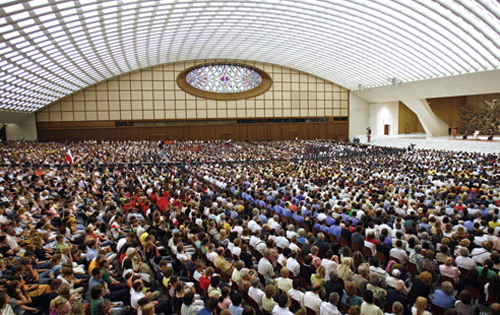When, how, and why did the Pope begin the now-traditional Wednesday audiences?
For the thousands of pilgrims who crowd St. Peter’s Square (or the Paul VI Audience Hall during winter) weekly, the Wednesday audience, during which the Pope greets and holds a catechesis for anyone who wishes to participate, seems to have always existed.
“Its introduction,” Archbishop Loris Capovilla, secretary to Pope John, explained to Vatican Insider, “must be attributed to Pius XI (born Achille Ratti), pope from 1922 to 1939.
It was he who began receiving young, recently married couples in the Apostolic Palace every week on Wednesday.
Then the meeting was extended to other kinds of pilgrims, without distinction.
The Pope continued to reserve special audiences for particular groups on other days of the week, but the Wednesday meeting remained a fixture.”
Pius XII (1939-1958) did the same, preparing a large audience hall in the Castel Gandolfo residence. It should be remembered that, except in special cases, the Pontiffs used to limit themselves to greeting pilgrims with a few words, spending most of their time passing through the crowds to have direct contact with them.
John XXIII also wanted to maintain this custom, and when the pilgrims were too numerous for the Audience Hall of the Benedictions, he used St. Peter’s Basilica, sometimes repeating the audience on Saturday as well. Pope Roncalli (1958-1963) made a habit of giving a little speech, for example, commenting on the saint of the day or the liturgical celebration.
One year after his election, Paul VI (1963-1978) employed the architect Pier Luigi Nervi to design an audience hall in Vatican City. Work began in 1966 and the hall – called Nervi Hall – was inaugurated on 30 July 1971.
Not everyone knows that the great auditorium does not lie completely within the borders of the Vatican City-State. A substantial part, in fact, lies in the Italian area, though subject to the extraterritoriality conceded to the Holy See.
This is due to the fact that the Palace of the Holy Office and the area where the Oratory of St. Peter once stood were not assigned to the Papal States at the time of the Lateran Accords (1929).
The final part of Nervi Hall, however – today called the Paul VI Audience Hall – is within the confines of the Vatican. It contains the gigantic bronze sculpture by Pericle Fazzini, portraying the risen and glorious Christ, under which the Pope’s chair sits.
This means that, when the Pontiff speaks in the hall, he speaks from his own State, Vatican City, though most of the pilgrims there to hear him (at a capacity of 12,000 people) are not within the confines of the Vatican.
Since 2008, a functional solar panel system has been on the roof of the Paul VI Audience Hall, composed of 2400 panels that produce one-quarter of the energy needed for the hall and nearby buildings.
During summer, but also in winter months if climatic conditions allow, the Wednesday audience is held on St. Peter’s Square. It was at the start of the Wednesday audience of 13 May 1981 that John Paul II (1978-2005) was shot by Alì Agca, while riding among the faithful in an open white jeep.
During his pontificate, Pope Wojtyla held cycles of catechesis with specific topics planned for the Wednesday audiences, and his successor Benedict XVI has continued to do so.
Pope Ratizinger introduced the singing of the Pater Noster in Latin as a sign of unity for the faithful.
The catechesis, which the Pope holds in Italian, is then summarized in the other major languages, and he calls each of the various groups in the audience by name.
At the end, he performs the “baciamano” – one by one, the bishops present, dignitaries of other denominations, and pilgrims bearing gifts are introduced in the presence of the Pope.
The Prefecture of the Papal Household, led by the American archbishop James Harvey, prints and distributes - completely without charge - tickets for the audiences, using different colors according to the indicated area.






No comments:
Post a Comment